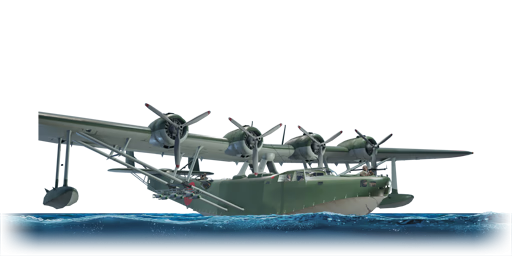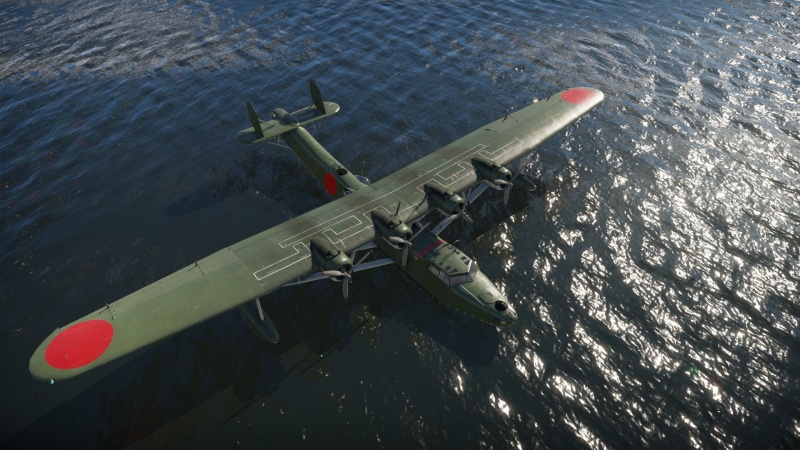H6K4
Contents
Description
The H6K4 is a rank I Japanese bomber with a battle rating of 2.0 (AB), 1.7 (RB), and 2.3 (SB). It has been in the game since the start of the Open Beta Test prior to Update 1.27.
General info
Flight performance
The H6K4 has decidedly bad flight performance given its large size. The aircraft has an abysmal top speed, meaning that it can be outrun by most biplanes at its battle rating. As well, the aircraft has lacklustre acceleration, and an almost-nonexistent climb rate. The aircraft's manoeuvrability is just as bad, given its massive size - turning and rolling are all rather difficult manoeuvres to perform. The aircraft can feel extremely sluggish (basically a brick with wings) when performing manoeuvres, even more so than conventional heavy bombers. The aircraft's camera angle in AB/RB is also extremely weird, as it looks downwards onto the aircraft. On the plus side, the aircraft has a slow stall speed, to permit its use as a hydroplane.
| Characteristics | Max Speed (km/h at 4,100 m) |
Max altitude (metres) |
Turn time (seconds) |
Rate of climb (metres/second) |
Take-off run (metres) | |||
|---|---|---|---|---|---|---|---|---|
| AB | RB | AB | RB | AB | RB | |||
| Stock | 311 | 303 | 9560 | 23.3 | 24.0 | 5.3 | 5.3 | 396 |
| Upgraded | 341 | 325 | 22.0 | 22.6 | 8.9 | 6.9 | ||
Details
| Features | ||||
|---|---|---|---|---|
| Combat flaps | Take-off flaps | Landing flaps | Air brakes | Arrestor gear |
| ✓ | ✓ | ✓ | X | X |
| Limits | ||||||
|---|---|---|---|---|---|---|
| Wings (km/h) | Gear (km/h) | Flaps (km/h) | Max Static G | |||
| Combat | Take-off | Landing | + | - | ||
| 0 | 450 | 498 | 469 | 320 | ~3 | ~2 |
| Optimal velocities (km/h) | |||
|---|---|---|---|
| Ailerons | Rudder | Elevators | Radiator |
| < 240 | < 240 | < 240 | > 341 |
| Compressor (RB/SB) | ||
|---|---|---|
| Setting 1 | ||
| Optimal altitude | 100% Engine power | WEP Engine power |
| 1,500 m | 1,050 hp | 1,123 hp |
Survivability and armour
- No armour protection
- Non-self-sealing fuel tanks (8 in the mid-fuselage, 6 in each wing)
Modifications and economy
Armaments
Suspended armament
The H6K4 can be outfitted with the following ordnance:
- 12 x 60 kg Navy Type 97 Number 6 bombs (720 kg total)
- 2 x 250 kg Navy Type Number 25 Model 2 bombs (500 kg total)
- 2 x 250 kg Navy Type 98 Number 25 bombs (500 kg total)
- 2 x 500 kg Navy Type Number 50 Model 2 bombs (1,000 kg total)
- 2 x 800 kg Navy Type Number 80 Model 1 bombs (1,600 kg total)
- 2 x 800 kg Navy Type 99 Number 80 AP bombs (1,600 kg total)
- 2 x 835 kg Type 91 Model 2 torpedoes
- 2 x 850 kg Type 91 Model 3 torpedoes
Defensive armament
The H6K4 is defended by:
- 1 x 20 mm Type 99 Model 1 cannon, tail turret (432 rpg)
- 1 x 7.7 mm Type 92 machine gun, nose turret (582 rpg)
- 1 x 7.7 mm Type 92 machine gun, 2 x beam turrets (582 rpg)
- 1 x 7.7 mm Type 92 machine gun, dorsal turret (582 rpg)
Usage in battles
The H6K4 is an interesting aircraft to fly in air battles, given its massive size, decent defensive armament and ordnance load. The aircraft can be used as a conventional bomber in Air battles, delivering its large payload on bases. It can also be used in naval battles, with its large load of two torpedoes and the ability to cap bases. However, no matter what way you play this aircraft, be aware that it is huge. The large size of the aircraft makes it an attractive target for fighters, SPAAs and naval AA guns alike.
The first possible playstyle for the H6K4 is that of a conventional bomber - the aircraft's large payload of 1,600 kg (2 x 800 kgs) allows it to destroy bases with ease. However, there are several limitations to this approach that should be considered. Firstly, the aircraft lacks landing gear (because it is a hydroplane), meaning that it is unable to land on conventional airfields. You can still try, but take care to land the aircraft slowly to avoid the risk of crashing. As well, the aircraft only carries two bombs max - this limits the number of bases, or targets, that you can hit. Depending on circumstance, a single bomb may not be enough to destroy a base - in that case, you will need to expend both bombs on a single base.
The second option for this aircraft would be in naval battles. The aircraft's large armament and floatplane abilities allow it to be used as a base-capper. The aircraft carries a pair of Type 91 torpedoes (Model 2 or 3) which are highly effective against any target up to destroyer-size. However, these torpedoes will be hard to aim against small targets such as MTBs, as smaller vessels are typically very manoeuvrable. Note that you may want to attack from afar when flying this aircraft - the aircraft is unarmoured, and any hits from ship-based AA guns may set your large plane on fire.
If being pursued by enemy fighters, the H6K4's massive size and slow speed will prevent it from running away effectively. Thus, your only hope would be the H6K4's defensive armament - this is one sector where the H6K4 excels. Being a Japanese bomber, the H6K is very well armed for its BR and carries a total of five guns. There are four single 7.7 mm machine guns, and a 20 mm cannon in the tail position. However, note that the H6K4 doesn't have any defensive positions underneath the fuselage - after all, it is a hydroplane. This means that you are completely vulnerable from underneath. To remedy this, attempt to bait pursuing aircraft above you or behind - this way, they can be hit by the highly-effective 20 mm cannon defending the rear.
Manual Engine Control
| MEC elements | ||||||
|---|---|---|---|---|---|---|
| Mixer | Pitch | Radiator | Supercharger | Turbocharger | ||
| Oil | Water | Type | ||||
| Not controllable | Controllable Not auto controlled |
Controllable Not auto controlled |
Controllable Not auto controlled |
Separate | Not controllable 1 gear |
Not controllable |
Pros and cons
Pros:
- H6K for Flying boat:
- Bomber spawn
- Landing floats
- Can capture points in Naval
- Decent combined defensive armament
- 2 x Type 91 Aerial Torpedo
- Torpedo has the highest drop speed in the game at 580 km/h and is one of the most feared torpedoes in Naval Battles
- 12 x Type 97 No.6 Land Bomb (60 kg)
- Gets 2 x bomb racks of 6 x 60 kg bombs which can be used to hit multiple targets
- 2 x No.80 Land Bomb (800 kg)
- Heaviest bomb Japanese Navy can offer
Cons:
- H6K for Flying boat:
- Huge target
- Slow
- Lack of land-suitable gear
- Very unreliable to land on regular run-ways
- Bombs drop in series
- Common Navy plane construction:
- Poor defensive armament: 7.7 mm Type 92 MG
- Fragile, little armour, and no self-sealing fuel tanks
- H6K specific:
- Awkward default camera angle
History
In-game description
A quad-engined all-metal parasol-wing monoplane flying boat. An experimental version, the Type S, made its first flight on July 14, 1936. The plane was approved by the Imperial Japanese Navy as Type 97 Large Flying Boat in 1937. Mass production began in 1938.
The most common variant was model 22 (H6K4), created in 1940. The first 119 planes were fitted with a air-cooled 14-cylinder twin-row radial Mitsubishi Kinsei 43 engine (1000 hp). Afterwards, the slightly more powerful Kinsei 46 was used. The H6K4 carried more fuel than earlier models, increasing its maximum range to 25 hours, or 6000 kilometers. Its fuselage included waist blisters fitted with machine guns, which required a slightly longer tail section.
The H6K4 was armed with four 7.7mm Type 97 (Lewis) machine guns with 582 rounds apiece and, in the tail turret, one 20mm Type 99-I cannon with 432 rounds. The flying boat could carry twelve 60-kg bombs, four 250-kg bombs, or two 800-kg Type 91 Model 1 torpedoes.
A major weakness of all H6K flying boats was the lack of protective armor for the crew and for the fuel tanks. This was sacrificed for the sake of its extended flight range. When the plane started to suffer losses in combat, designers of later Model 22 planes began to focus on protecting the crew.
The H6K flying boat's first combat action was a raid on Wake Island on December 11, 1941. The plane was widely used in the Pacific theater during the first part of the war. The H6K ran long-range reconnaissance missions, convoy escort duty, submarine searches, bombing missions, and search and rescue operations. When the newer H8K arrived, the H6K began to be used mostly as a transport plane. The plane was in operation until the Japanese surrender in 1945.
127 H6K4s were built, out of a total of 217 H6Ks.
Media
- Skins
- Videos
See also
- Related development
- Aircraft of a similar role, configuration or era
External links
| Kawanishi Aircraft Company (川西航空機) | |
|---|---|
| Fighters | J6K1 |
| N1K | N1K1-Ja · N1K2-J · N1K2-Ja |
| Bombers | H6K4 · H8K2 · H8K3 |
| Hydroplane | N1K1 · E7K2 |
| Japan bombers | |
|---|---|
| Navy | |
| Carrier-based attack bomber | |
| B5N | B5N2 |
| B6N | B6N1 · B6N2 · B6N2a |
| B7A | B7A2 · B7A2 (Homare 23) |
| Carrier-based dive bomber | |
| D3A | D3A1 |
| D4Y | D4Y1 · D4Y2 · D4Y3 Ko |
| Shipboard Observation seaplane | |
| F1M | F1M2 |
| Land-based Attack bomber | |
| G4M | G4M1 |
| G5N | G5N1 |
| G8N | G8N1 |
| Flying boat | |
| H6K | H6K4 |
| H8K | H8K2 · H8K3 |
| Land-based Bomber | |
| P1Y | P1Y1 |
| Army | |
| Light | Ki-32 |
| Ki-48-II otsu | |
| Heavy | Ki-21-Ia · Ki-21-I hei |
| Ki-49-I · Ki-49-IIa · Ki-49-IIb · Ki-49-IIb/L | |
| Ki-67-I Ko · Ki-67-I otsu | |
| Other countries | ▅B-17E |





